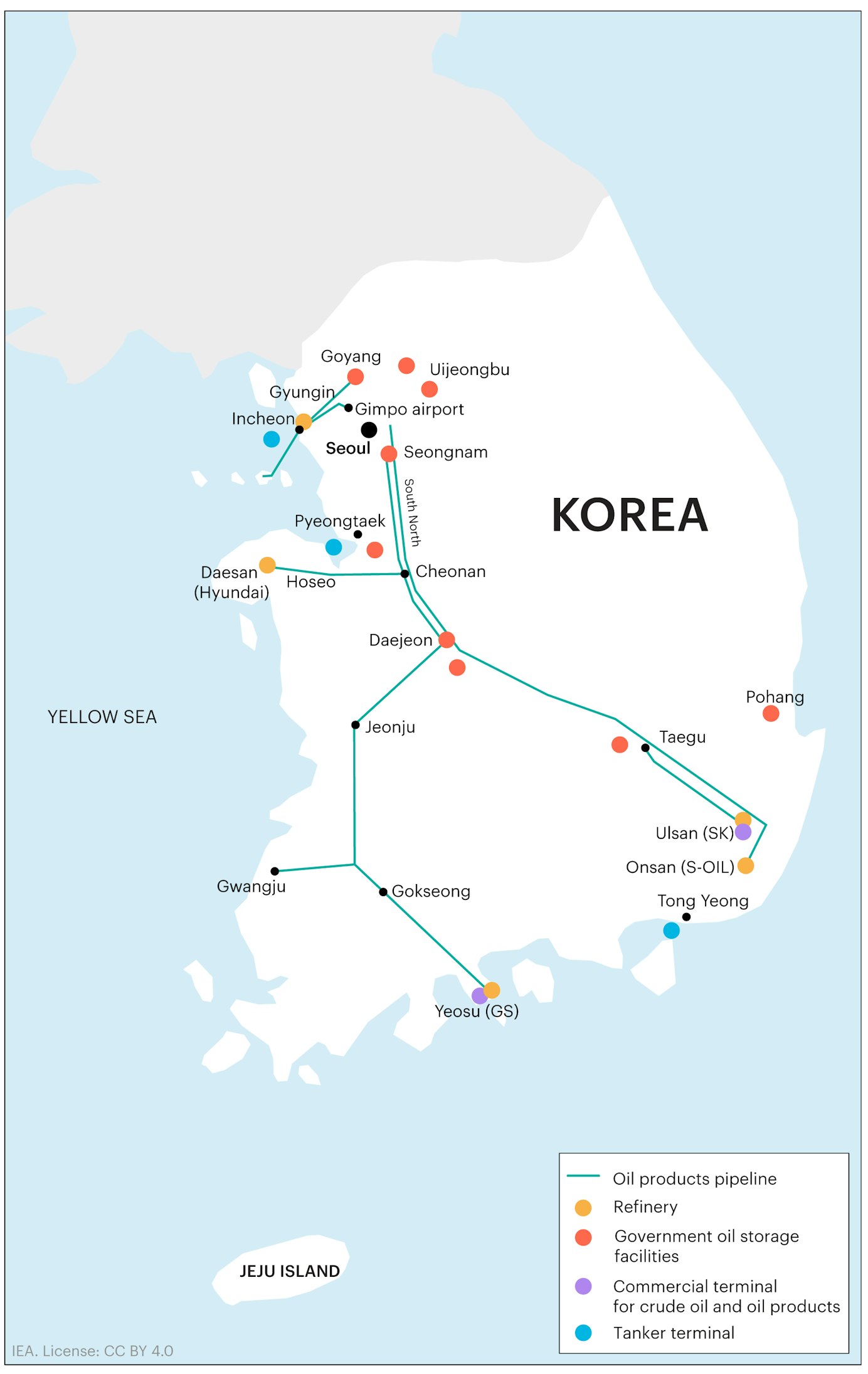Korea Oil Security Policy
This report is part of Oil Security Policy
Oil overview
The use of emergency oil stocks is central to Korea’s emergency response policy. Korea meets its stockholding obligation to the IEA by holding government stocks and by placing a minimum stockholding obligation on industry. Demand restraint measures can also be implemented during severe emergencies.
Oil remains the most significant energy source in Korea in terms of total energy supply. Oil consumption has generally trended upwards since the late 2000s, with demand for naphtha being particularly strong due to Korea’s large petrochemicals industry. Korea has a very significant refining industry and is self-sufficient in most products, apart from petrochemical feedstocks. However, it is a major net importer of crude oil.
Oil infrastructure
Pipelines
Korea relies exclusively on tanker shipments to supply its large refining industry with crude oil.
Daehan Oil Pipeline Corporation (DOPCO) owns the national oil product pipeline network. The DOPCO pipeline system connects refineries with major cities, airports and stockholding facilities. DOPCO is a private entity owned by the four major domestic refiners. The six domestic oil product pipelines operated by DOPCO have a total length of 1 105 km.
Ports
Korea’s oil port infrastructure is well developed; there are 23 sea ports and three container terminals. Five oil port terminals are owned by Korea National Oil Corporation (KNOC), the national oil and gas company of South Korea. An additional five oil port terminals are located at the refineries and owned by refiners. For crude oil imports, the total capacity is around 14.4 million barrels per day (mb/d); for imports and exports of oil products, the total trade capacity of these terminals is close to 9 mb/d.
Refining
With a capacity of 3.5 mb/d, Korea has one of the world’s largest oil refining capacities.
SK Innovation has two refineries, one in Ulsan (840 kb/d) and another in Incheon (375 kb/d). The other refineries are held by GS Caltex in Yeosu (800 kb/d), by S-Oil in Onsan (669 kb/d) and by Hyundai Oilbank in Daesan (520 kb/d). In addition to those five large refineries, Korean refiners operate processing units that convert ultra-light grade crude oil (condensate) into products such as naphtha for petrochemical use.
Crude oil net imports in Korea, 2000-2021
OpenKorean refiners have sourced increasing shares of their crude oil needs from the United States since 2018 but a strong reliance on Middle Eastern grades remains.
Oil products' net exports in Korea, 2000-2021
OpenStorage
Korea holds strategic and commercial oil reserves in both crude oil and oil products. The combined storage capacity stands at almost 400 mb. Government stocks and international joint oil stockpiling account for 35% of the storage capacity. There are nine government storage facilities. The remaining capacity relates to commercial facilities, including for obligated industry stocks.
Korea’s oil infrastructure, 2022

Oil emergency response policies and measures
Organisation
The 2017 Petroleum and Petroleum Substitute Fuel Business Act (PAPSA) and the 2016 Energy Act (EA) provide the legal framework for Korea’s oil emergency response.
According to article 8(3) (EA), the Minister of Trade, Industry and Energy (MOTIE) decides whether or not to use emergency reserves. MOTIE is also charged with preparing plans to reduce consumption in emergency situations.
The President of Korea acts as the head of national crisis management, including responding to oil supply disruptions. In practice, MOTIE is the leading governmental body responsible for responding to oil supply disruptions. In such cases, MOTIE will closely consult with other relevant governmental entities, such as Ministry of Foreign Affairs, Ministry of Economy and Finance, and Ministry of Interior and Safety, as well as with domestic industry.
Emergency oil stocks
Korea meets its stockholding obligation to the IEA by holding government stocks and by placing a minimum stockholding obligation on industry.
The 1979 Korea Petroleum Corporation Act established KNOC to manage the storage of Korea’s government emergency stocks. KNOC is also the operating agency for government and obligated industry stocks. The Korean government holds public stocks based on average daily sales. There is no ticketing system and Korea has no bilateral agreements to hold stocks on the behalf of other IEA Member countries.
The Korean government also places minimum stockholding obligations on industry. Korea obliges crude oil refiners to hold 40 days of stocks based on the average daily sales in domestic market. LPG importers and by-products distributors (the petrochemical companies that produce ethylene or propylene using naphtha or LPG) are required to hold respectively 15 days and 30 days of stocks based on the same metric.
Demand restraint measures
Demand restraint measures that could be considered in case of an oil crisis include public awareness campaigns, temperature and lighting control of buildings, voluntary or mandatory restrictions on vehicle use, regional oil allocation to major oil consumers, and restrictions on refinery operations.